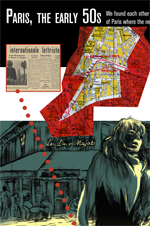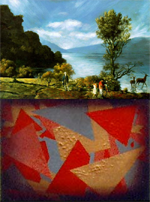Request for Proposals
Click for Proposal Submission Form
While the submission window is closed for Voke issue 2, Voke is still accepting proposals for visualized research objects, and submissions of completed visualized research objects, to include in upcoming issues.
Proposals should include:
- A short abstract (~250 words) describing the proposed project’s area of research
- A detailed plan (~250 words) of the proposed form the visual research object will take
- Responses may also include images or links to prior visual work by the author, or sketches/prototypes of the proposed project – though the project proposed must not have been previously published elsewhere. A portfolio of prior visual work is not necessary, however, and we welcome non-artist researchers to propose collaborations with visual artists.
Preference will be given to proposals that have a clear vision for the ultimate shape of their project and how it will be presented on Voke. Broadly, pieces on Voke consist of two components:
- A visual research object ready to be viewed on the web. Voke is not a blog, we don’t simply insert your work into a template. You should determine what form of online presentation best suits your work. See What is Visualized Research? below for examples of the breadth of forms your research could take.
- A written research document. APA cited and formatted. This text will serve as a literature review and as a textual complement to your visual piece.
Interested contributors may use the proposal submission form linked above, and further questions can be directed to us at email hidden; JavaScript is required.
If accepted, your proposal will be assigned to two members of the editorial board, who will provide initial feedback on your proposal and ongoing support in the realization of the project and its integration into the site. Your final textual literature review, and a draft version of your object, will be due by October 3rd, 2014, and your assigned board members will provide feedback on the piece. The final version of the project will be due December 5th, 2014.
If you have a completed, unpublished, visualized research project, or have completed, unpublished textual research you wish to articulate visually in Voke, your submissions are also welcomed!
Review Criteria for Proposals
The Voke editorial staff and board will consider the following criteria in reviewing submission proposals. In the spirit of seeking out emerging and current ideas, your research does not to have to be completed prior to proposal submission, however, if accepted Voke will collaborate with you on an editing calendar that must be adhered to. If your research is complete (ie: Thesis, Action Research project, Dissertation, etc.) Voke also seeks your proposal so long as it has been completed within the last three years, and the written component of your research has not been previously published.
- Provocative Research Question: The research topic is clearly identified and a line of inquiry is proposed. Research is intriguing, new, original, provocative, and current.
- Art Education Relevancy: The proposal relates to, or explores themes relevant to, the arts and learning.
- Visualized Research Component: The proposal clearly outlines the planned visual articulation of the research and may include examples of previous/related artwork that supports the research. One of the strengths of the works included in Voke is the variety of visual forms this work can take. Voke is not a blog – we don’t simply insert your work into a predesigned template. You will need to determine what form of online presentation best suits your work – and develop that form. Your editors can provide support in this process, and suggest tools and resources, but ultimately the responsibility for your piece’s on-line presentation is yours.
- Clarity of Proposal: The proposal research is clearly explained and supported.
- Academic Rigor: The proposal indicates that the final written and visual research will demonstrate academic rigor. Examples include proper use of citations (if included), writing ability, and sophistication of ideas.
- Research has not been previously published: However, if the contributor wishes to expand upon or frame previously (up to date) published work within a different, original context, Voke will consider the proposal.
By emphasizing the art in art education research, a field historically characterized by written scholarship, Voke aims to engage a diverse audience and facilitate dialogue among researchers, artists, teachers, and students. Our goal is to present fresh ideas in artistic forms that reflect and inspire provocative thought. Contributions require two main components: a citation-driven literature review, and a visualized research object articulating and expanding upon that body of research. These pieces take full advantage of digital media to offer readers alternative means of encountering information. Short films, interactive documents, procedural artwork, podcasts, screencasts, poetry, games, and photography are all possible examples of visualized research; they creatively represent research in an effort to challenge surface-level interaction with ideas.
For examples of visualized research projects, look at some of the projects on the Voke frontpage, or at the examples on Kairos, a technology and rhetoric journal which presents similar work of a different disciplinary bent (for instance, Deborah Balzhiser et al.’s The Facebook Papers, which appropriates the form of a Facebook page, and its inherent structural biases, to document and discuss the project of using Facebook in teaching undergraduate writing).
Vectors is another tech and culture journal which features exclusively electronic, multimedia presentations of research (for example, McKenzie Wark’s Totality for Kids, a hypertextual graphic novel framing the history of the First Situationist international, or Greg J. Smith and Erik Loyer’s Critical Sections, which deconstructs and juxtaposes filmic, textual, and architectural representations of the city of Los Angeles). An example of traditional media used to visualize research data can be found in Somewhere Nowhere: Lives Without Homes, by Brown, Somerville, Scullion, and Morris, who published the results of their research into homelessness in the UK as a graphic novel. Within the fine arts world, one may look at the example of Komar & Melamid’s Most Wanted Paintings, in which copious granular survey data was ultimately realized in the form of a “Most Wanted” and “Least Wanted” painting from several different countries.
Other exemplars beyond academic journals include the New York Times online feature The Russia Left Behind, which weaves design, interactivity, video and photo into a single multimedia text, or Darius Kazemi’s examination of the level-generation algorithms of the indie game Spelunky, which embeds a modified version of the game itself into the text which illustrates the underlying designed structures of the game.
To search for tools used to create different kinds of visualized research, Bamboo Dirt has a searchable, sortable database of free and commercial tools used in the Digital Humanities, organized by project type.
If you are a researcher looking to collaborate with a visual artist, or an artist looking to collaborate with a researcher, on a visualized research project, DH Commons provides a hub to contact collaborators with complementary skillsets.




